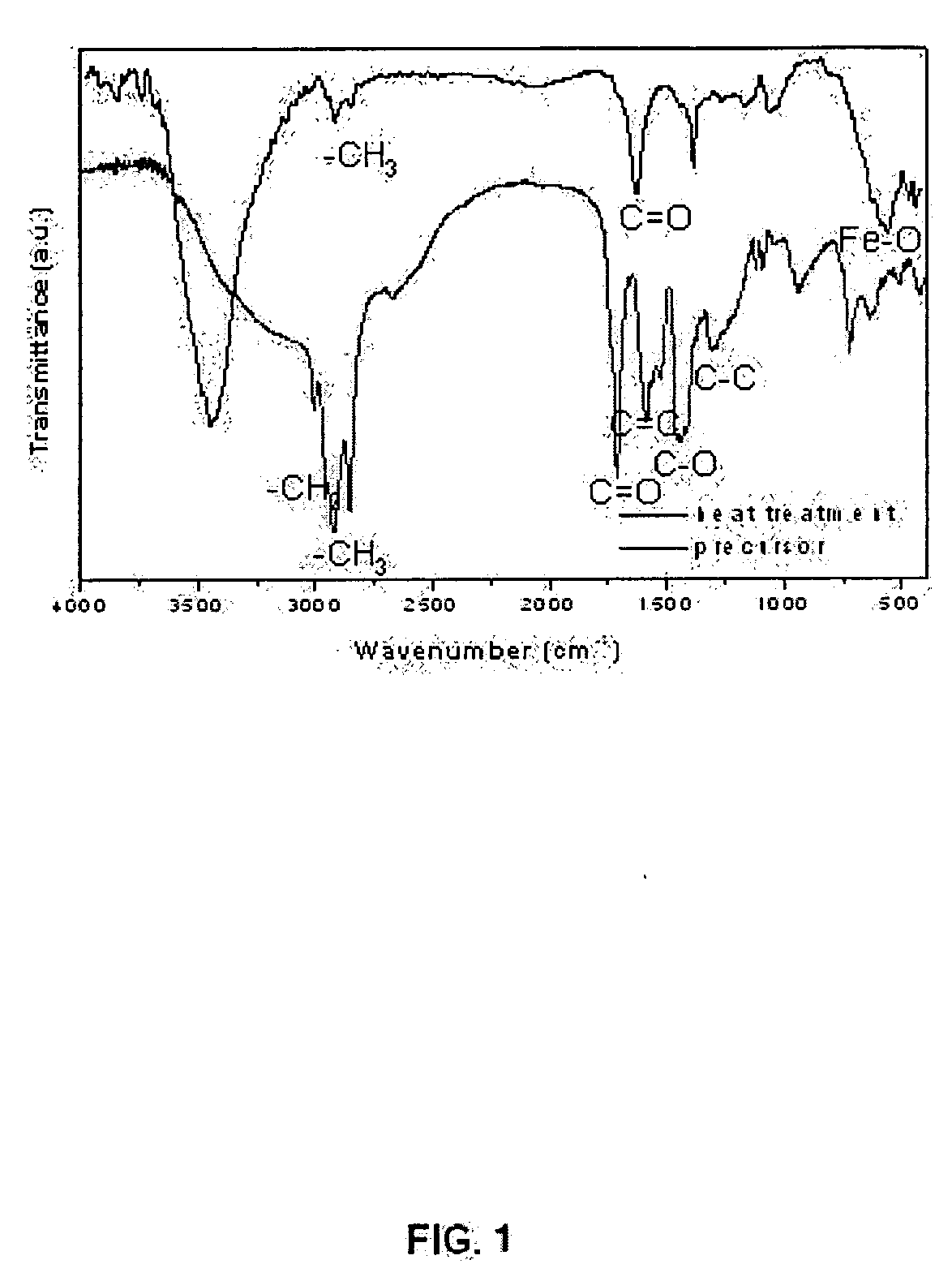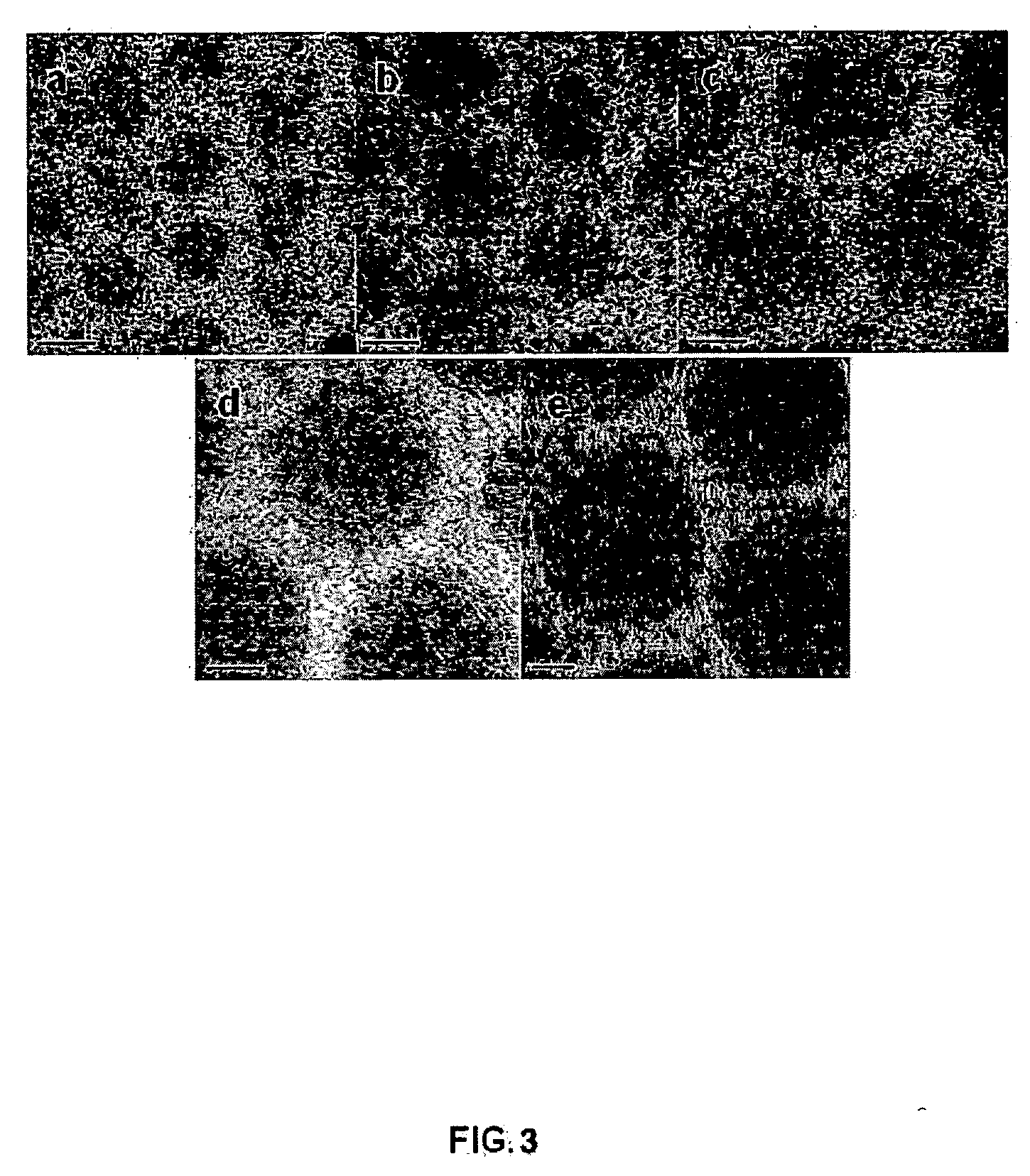Process for large-scale production of monodisperse nanoparticles
- Summary
- Abstract
- Description
- Claims
- Application Information
AI Technical Summary
Benefits of technology
Problems solved by technology
Method used
Image
Examples
example 1
Synthesis of Iron-Oleate Complex
[0059] As the first exemplary example for demonstrating the method of synthesizing monodisperse nanoparticles according to the present invention, 10.8 g of iron chloride [FeCl3.6H2O, 40 mmol] and 36.5 g of sodium oleate (120 mmol) were dissolved in a mixture of solvents containing 80 mL of ethanol, 60 mL of distilled water, and 140 mL of hexane, and thereafter the resulting mixture was heated to 70° C. and kept at the same temperature for 4 hours to obtain an iron-oleate complex. During this process, the initial scarlet color in aqueous phase became clear, and the initial transparent organic phase turned to scarlet, indicating that iron-oleate complex was successfully synthesized. When the reaction was completed, the upper organic layer containing the metal-oleate complex was separated and thereafter the hexane was evaporated off, resulting in a waxy solid form. In FIG. 1, the FT-IR spectrum of the resulting iron-oleate complex shows a C═O stretching...
example 2
Synthesis of Monodisperse and Spherically Shaped Iron Oxide Nanoparticles in Large Quantity—(A)
[0060] As a first exemplary example of the ultra-large scale synthesis of monodisperse and spherically-shaped iron oxide nanoparticles according to the present invention disclosed here, 36 g of iron oleate complex synthesized according to example 1 was added to a mixture containing 200 g of dehydrated octadecene and 5.7 g of oleic acid under inert atmosphere at room temperature.
[0061] The resultant mixture was heated to 320° C. and then was aged for 30 min. maintaining the same temperature, during which process, a violent reaction took place, and the initial transparent solution became brownish black, indicating that the iron oleate complex was decomposed completely, and iron oxide nanoparticles were generated.
[0062] The resulting solution containing the nanoparticles was cooled to the room temperature, excess ethanol was added to yield a black precipitate, and then separated by centrif...
example 3
Synthesis of Monodisperse Spherical Iron Oxide Nanoparticles in Large Quantity—(B)
[0069] In order to synthesize monodisperse and spherically shaped iron oxide nanoparticles of 5 nm in diameter according to the present invention, a procedure similar to Example 2 above, was carried out; 18 g of iron oleate complex was added to a mixture containing 100 g of dehydrated hexadecane and 5.7 g of oleic acid under an inert atmosphere and the resulting mixture was heated to 280° C. and then aged the mixture for 1 hour at the reflux temperature, whereby the colloidal iron oxide nanoparticles of 5 nm in diameter were formed. The resulting solution was cooled to room temperature.
[0070] Then ethanol was added to wash, resulting in a black precipitate, followed by centrifugation at the revolving speed of 2000 rpm, retrieving the precipitated nanoparticles. Thereafter, this washing process was repeated at least three times, and the ethanol was removed by vacuum drying to yield the desired iron ox...
PUM
| Property | Measurement | Unit |
|---|---|---|
| Temperature | aaaaa | aaaaa |
| Time | aaaaa | aaaaa |
| Cooling rate | aaaaa | aaaaa |
Abstract
Description
Claims
Application Information
 Login to View More
Login to View More - R&D
- Intellectual Property
- Life Sciences
- Materials
- Tech Scout
- Unparalleled Data Quality
- Higher Quality Content
- 60% Fewer Hallucinations
Browse by: Latest US Patents, China's latest patents, Technical Efficacy Thesaurus, Application Domain, Technology Topic, Popular Technical Reports.
© 2025 PatSnap. All rights reserved.Legal|Privacy policy|Modern Slavery Act Transparency Statement|Sitemap|About US| Contact US: help@patsnap.com



